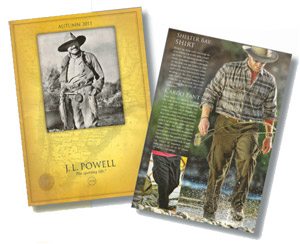
Great catalogs are no longer just about selling products. They must go further to emotionally connect with readers; they must offer options that engage customers; they must allow customers complete control over when and how they shop.
The era of Catalog 2.0 has begun, and marketers are scrambling to keep up.
One thing that hasn’t shifted is how people process this two-dimensional medium called a catalog. Like the laws of physics, the general rules have not changed, but they must be re-evaluated as catalogs continue to evolve.
These are some proven “Catalog Physics 101” theories, along with a few considerations for when you’re designing your next catalog campaign.
- Covers: still your most important real estate
Physics: Your front and back covers offer the most significant opportunity to engage readers and convert sales. Customers will interact with one or both of these pages before any other page in your catalog. Cover testing has proven this dynamic — this is your single biggest opportunity to move the needle.
Consideration: What is your single biggest opportunity to quickly grab attention and engage customers at any level? It’s critical that you blatantly present who you are (your brand) and why you matter (your higher purpose).
You must also consider what is unique and relevant to your audience and how you can use that knowledge to stand out in the mailbox. What you’ve presented in the past will not necessarily work in the future.
Take free shipping. While it still works for many merchants, it’s become a cost-of-entry offer for most and it no longer attracts the attention it used to. Similarly, a photo of a best seller may not necessarily motivate as it once did, now that the world is serving up new offers, new products and new experiences on a daily basis.
It’s essential that you understand your customers and their world in order to engage them emotionally. You must think out of the box! A few ideas:
-
Be different from everyone else on the block; not just your competitors, but all brands that your customers interact with on a daily basis.
-
Include an extraordinary image that still reflects your brand differentiation — perhaps a photo or graphic that delights, demands attention or a second glance.
-
Craft editorial copy that offers specific solutions to problems your customers have, with the promise of finding answers inside.
-
Emotionally connect using words, captions and pictures that demonstrate value beyond just price point (i.e. a life better lived, time saved, etc.)
-
Always include inside page references, along with the promise of a benefit or solution to a problem.
-
Include a contest or free content available online; remember that brands must engage customers at any level, whether they are ready to buy or not.
-
Entertain, but make sure it’s entertaining to customers — not just to you!
-
Your back cover should never be an afterthought — it’s often the first page seen. Make sure you include your most relevant and intriguing products and messages.
The goal here is to grab attention and get readers inside as quickly as possible.
-
- Hot spots and death valleys
Physics: Eyeflow studies show that 70% of a customer’s time with in a catalog is spent on the pages located in the front 25% and back 10% of your catalog. Thirty percent of readers begin at the back of the catalog.
The middle-front and back pages are considered “valleys,” as they do not garner as much readership. Hot spots can be created with an order form insert or blow-ins.
Consideration: Most catalogers do a great job of placing better selling products and categories within the hotter pages of the catalog. But too many opening spreads today are filled with repetitive and often boring content. Or, worse yet, the first spread is completely ignored, with little or no brand positioning.
Your opening spread provides an incredible opportunity to engage, excite, inform or direct readers to products or solutions relevant to their world. With every catalog campaign, you should revisit this important real estate and think of it as your elevator message. How can you quickly, succinctly and visually state why your brand matters, and then direct the reader to the next stage of engagement?
Consideration: Most marketers do not spend time on or create designs to build excitement about those spreads located within the “valleys.” Instead of regarding these pages as a depository for those not-so-good products, brainstorm unique ways to make these pages to stand out.
This is called pacing your book, which will ultimately engage readers for a longer period of time and thus help boost your sales and average order values. The following are proven techniques used to warm up those valleys:
-
Implement themed spreads that move beyond a mere collection of similar products on a page; they should offer solutions to specific problems relevant to customers.
A theme will not jump off the pages unless you pull it together with additional graphics (possibly a lifestyle shot), a unifying headline, editorial support or other design techniques that quickly and visually offer the promise of a solution or create aspiration. Well-supported themes create value and will typically garner better response.
-
Employ completely different design architecture. This does not mean using design spreads that are foreign to your brand — but you should shake things up enough to stop readers.
Our minds are conditioned to look for things that are different or unique. By creating uniqueness, you create stopping power.
This may lead to more density or less density, depending on your normal spread framework. It might mean using color in a loud or different way, or even creating a unique border — anything the reader is not expecting.
-
Create a new hot spot by including an insert. These do not always have to be placed in the center. Inserts are a wonderful way to exploit a special offer or introduce a new or unique category. Inserts by themselves are a hot spot and, if well executed, will drive additional response.
-
- Spread eyeflow
Physics: It doesn’t matter if consumers read from the back of a catalog or begin at the front; the upper right of every spread is still considered a landing zone for the eye. Furthermore, spreads that include an image in this area will always get more attention than those with copy or white space.
Typically, the eye will travel in a “sideways U” pattern around the outside of a catalog spread, with decreased attention on the gutter. A strong headline or graphic located in the center of the spread will disrupt the normal pattern — which is fine as long as it’s part of the design plan.
Consideration: If customers pause on a spread, realize they are emotionally engaged and looking for something to feed their curiosity. So the goal of every spread should be to create “linger time.”
Many catalogers have a design mandate driven by square-inch analysis. This is a dangerous habit that can drive a talented designer into a boring corner. While it’s critical to highlight best-sellers, great design cannot be driven by square inches alone. Breakthrough design is driven by what will excite and engage customers. These are a few proven techniques:
-
Consider doing more with the upper right-hand corner than just giving more space to a best seller, which doesn’t always guarantee attention. Instead, include visuals, copy or graphics (along with a best-seller) that will add “wow” factor. This might mean including more white space than usual, or adding a lifestyle photo — anything that will stand out.
-
Consider ways to take your photography to the next level, adding intrigue to your photography while still selling product. You might add more lifestyle images, or try a photography style that is unique and different from your competitors.
-
Carefully written headlines provide additional stopping power when designed to pop off the page. Headlines that merely state the obvious (what is on the page) are a waste of space. Consider an emotionally charged headline that speaks to a solution, provides additional value, connects a theme or even includes humor — as long as it remains on-brand.
-
What can you provide that will engage customers that is relevant to their world or help in the decision-making process? You must do what it takes to connect with and engage customers in a “dialogue.”
If you provide additional information or more products online, it’s critical that you include a strong benefit-oriented call-to-action, giving customers a real reason to go online. Be the brand that provides the content customers desire as long as you are uniquely suited to deliver it.
-
Don’t hide customer testimonials! The success of online customer reviews shows that these are important. Consider including the five-star graphic designations next to your best-sellers.
And don’t waste valuable space using testimonials only to talk about general customer service attributes. Consumers want affirmation from others that products work.
-
- Graphic hierarchy
Physics: In most cases, there is a distinct hierarchy on a catalog page: The product image is viewed first, then the price point, and then copy. But this pattern is interrupted when catalogers place a graphic “attention-getter” next to the product image.
When a photograph cannot quickly interpret a special feature, benefit or value, you must use an attention-getter to provide any additional explanation needed. Otherwise, the price may not support what is visually presented, and consumers may not continue the process and read the body copy.
Consideration: Every product should provide special value as it relates to your brand. But don’t confuse value with “low price.” Value can be interpreted as the emotional takeaway or a special need the product satisfies.
Studies have shown that consumers are willing to pay more if a specific need is satisfied. This need can be something as basic as elevating customer’s social worth (I’m special, more popular, etc.).
-
Use additional graphics or copy to exploit this perceived value. If you are using an additional inset photo, make sure the caption isn’t wasted on feature-copy alone. Sometimes it’s just a matter of using a simple descriptor, like “Italian crafted,” if it demonstrates the quality customers are looking for.
-
Catalogs continue to be an important ingredient in the multichannel mix. So don’t get caught up in the sentiment that “they won’t be around forever” and then lose an opportunity to create a more powerful selling tool.
All of the techniques described above require a keen insight into customer’s perception and expectations of your brand. Customer research allows you to manage the risk of taking your design efforts to a new and different level.
Lois Brayfield ([email protected]) is president of J. Schmid & Associates, a catalog/multichannel marketing consultancy.
